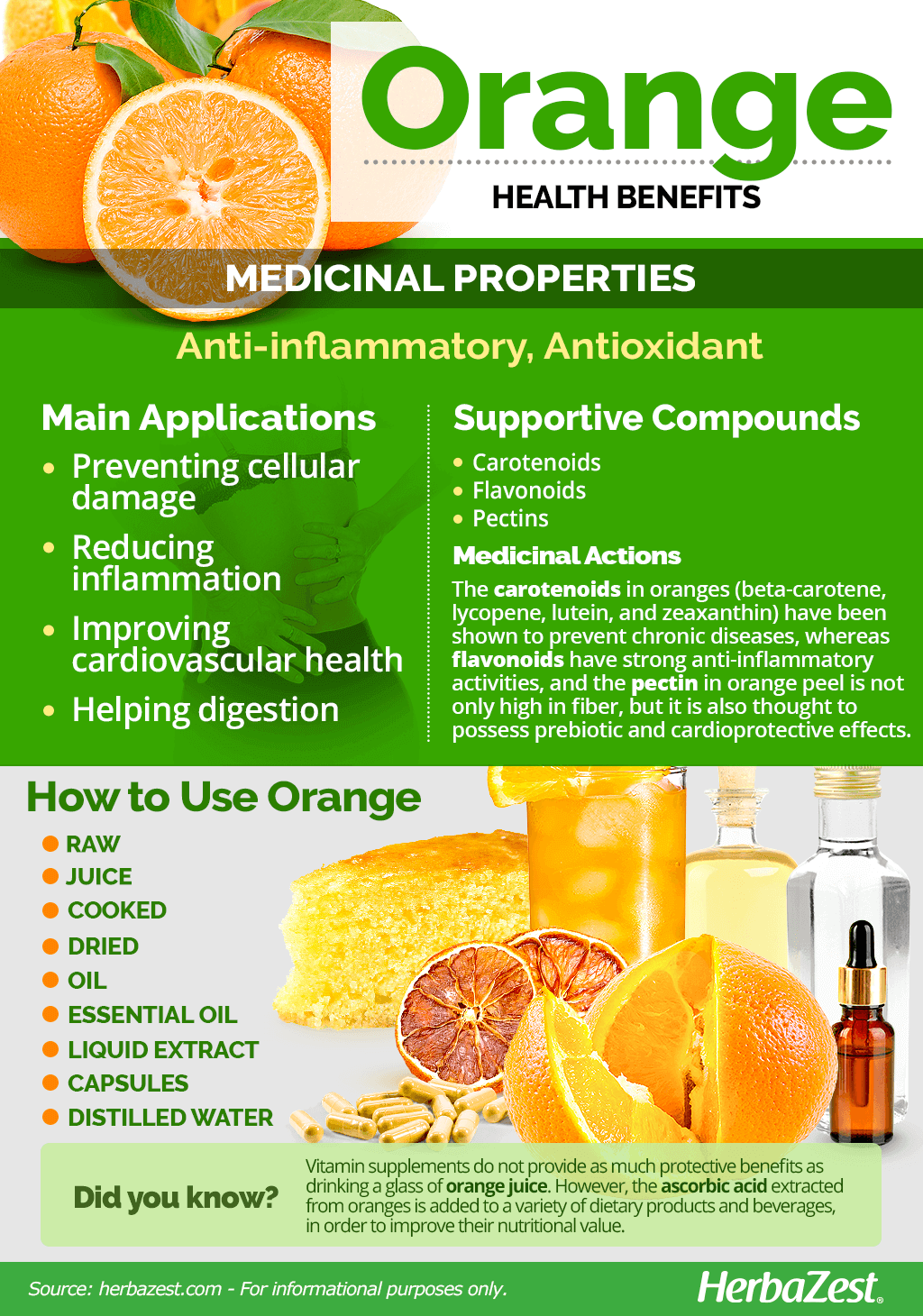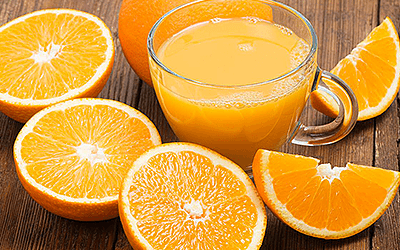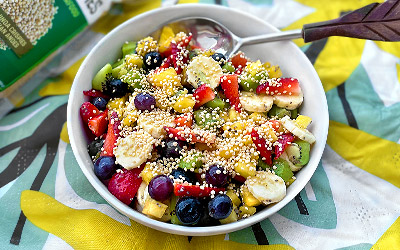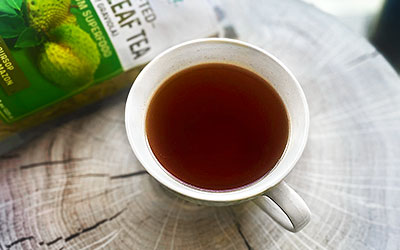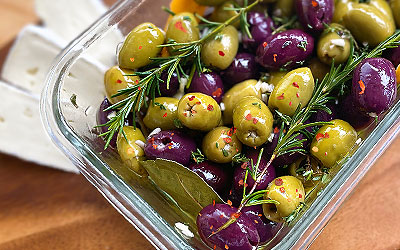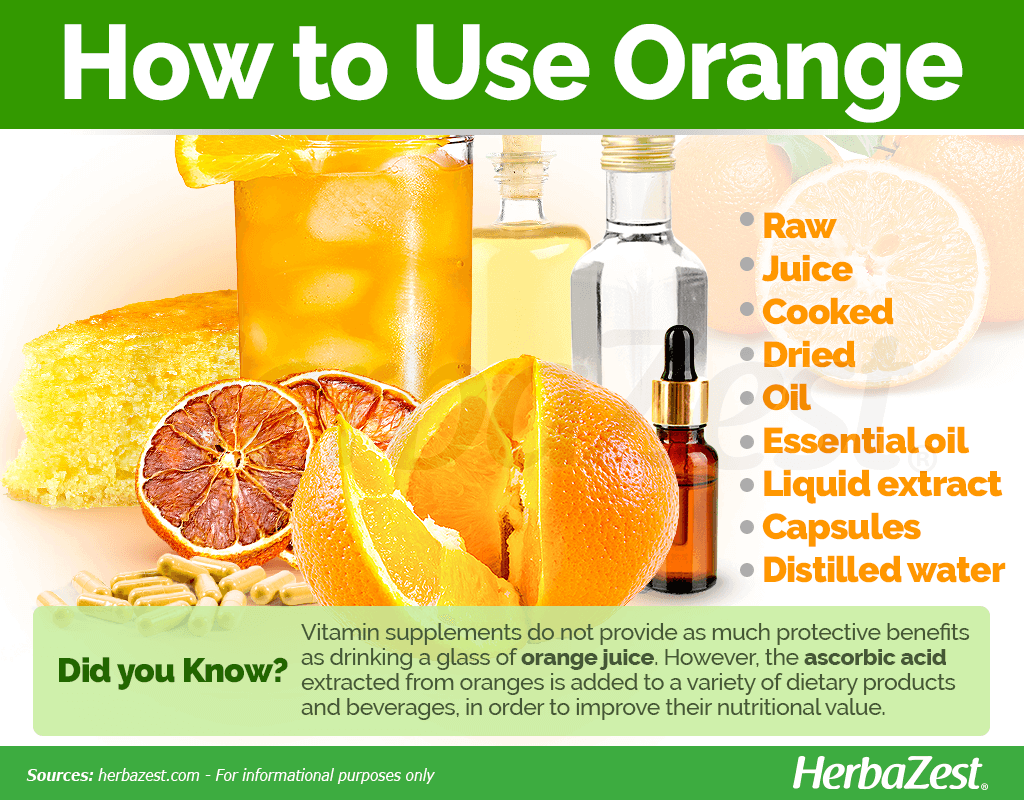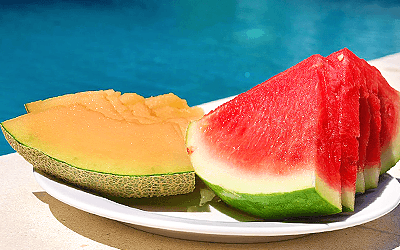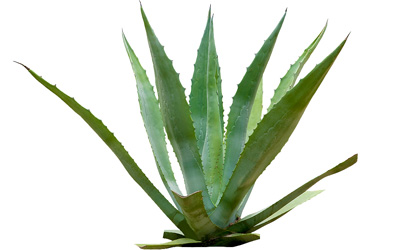Hailing from Asia, the tasty, juicy orange fruit is now cultivated around the world, mainly in subtropical climates, not only for its delicious flavor and nutritional content, but also for its medicinal value. Learn more about the many health benefits of oranges, their history, and how to consume these citrus fruits.
Orange Medicinal Properties
- Medicinal action Anti-inflammatory, Antioxidant
- Key constituents Carotenoids, flavonoids, and pectins
- Ways to use Capsules, Liquid extracts, Food, Juiced, Dried
- Medicinal rating (3) Reasonably useful plant
- Safety ranking Safe
Health Benefits of Oranges
Due to its mildly citrus and sweet flavor, oranges are probably one of the most popular fruits around the world and are considered a staple of nutrition. Some of the most remarkable benefits of oranges are:
Preventing cellular damage. Like most fruits, oranges have an antioxidant potential, hindering free radicals that destroy the cells, fighting harmful bacteria and viruses, and helping prevent degenerative diseases.
Reducing inflammation. Consumed in their natural form, without any additives, oranges have been associated with an important reduction of severe inflammatory conditions, like asthma, osteoarthritis, and rheumatoid arthritis.
Improving cardiovascular health. Many scientific studies have shown beneficial effects of consuming oranges on the treatment and prevention of cardiovascular diseases.
Helping digestion. Due to their high fiber content, oranges also work wonders for the digestive system, regulating intestinal transit and preventing constipation.
Additionally, the antioxidant activity of orange's compounds has been linked to a reduction in the development of atherosclerosis. The citrus fruit also possesses antimicrobial properties.
How It Works
Oranges are a powerhouse of phenolic compounds, including flavonoids and pectins. The main flavonoids found in citrus species - hesperidine, narirutin, naringin, and eriocitrin - appear to be responsible for the anti-inflammatory activities of oranges and other citrus fruits.1
Similar to other brightly colored fruits and vegetables, the orange fruit is rich in carotenoids, which are natural pigments with great antioxidant properties. The functional properties of carotenoids (including beta-carotene, lycopene, lutein, and zeaxanthin) have been extensively studied and shown to prevent several major chronic diseases.2
Carotenoids play an important role in protecting cells from oxidation and free radicals' damage.
Pectin is a complex carbohydrate found in the peel of oranges and other citrus fruits. As a food additive, it is commonly used to thicken jellies and fruit fillings for pies and other desserts. Scientific studies have found that pectin is high in fiber and possesses a potential prebiotic effect as well as the ability to lower LDL cholesterol, which can lead to cardiovascular benefits.3
A relationship between fresh orange consumption and respiratory function in both children and adults has also been established, although is not clear whether childhood dietary habits have an influence on adulthood.
Orange extract seems to have also antithyroidal and hypoglycemic properties, which might potentially aid both thyroid disorders and diabetes, although further studies are necessary.
The sugar content in oranges is composed by fructose, glucose, and sucrose, best-known as 'simple carbohydrates.' However, contrary to popular belief, oranges have a low glycemic index (GI 40), which doesn't greatly differ from other low-carb fruits, such as apples (GI 39), strawberries (GI 41), and peaches (GI 42). However, in order to avoid sugar spikes, it is recommended to consume orange juice with pulp, which is full of fiber that slows down glucose absorption.
THE POPULAR MYTH THAT ORANGES CAN IMPROVE COGNITIVE FUNCTION HAS BEEN DEBUNKED. THERE'S NO CONCLUSIVE EVIDENCE ABOUT ORANGE FLAVONOIDS' EFFECTS ON BRAIN POWER.
Other herbs with great immune boosting, antioxidant properties are bell pepper, camu camu, and lemon, whereas cabbage, devil's claw, and turmeric also provide anti-inflammatory benefits.
Side Effects of Orange
Orange is a very healthy fruit, and it is considered generally safe for consumption. However, excessive intake can lead to some uncomfortable symptoms, like abdominal cramps and diarrhea.
Orange Nutrition
It's common knowledge that most of the benefits of orange are due to its outstanding levels of vitamin C (ascorbic acid). This water soluble nutrient is crucial for the proper functioning of the immune system as well as for preventing colds, cough, and recurrent ear infections.
However, the orange fruit is also rich in dietary fiber and provides good amounts of B complex vitamins, mainly B1 (thiamin), B5 (panthotenic acid), B6 (pyridoxine), and B9 (folate). These vitamins play an important role in cellular regeneration, proper brain functioning, and energy production. For this reason, oranges are highly recommended during pregnancy in order to ensure a healthy development of the fetus and prevent any birth defects. Other essential nutrients, present in small amount in oranges, are B2 (riboflavin), B3 (niacin) and choline as well as vitamins A (through carotene) and E (alpha-tocopherol).
Additionally, the orange fruit is an adequate source of some important minerals, such as potassium and copper, which are necessary for blood pressure regulation and red blood cells production, respectively. The nutritional value of orange is rounded by small amounts of calcium and magnesium, among other minerals.
One medium sized orange (131 g) provides only 62 calories, as well as 5% and 12% of the recommended daily value for carbohydrates and dietary fiber, respectively.
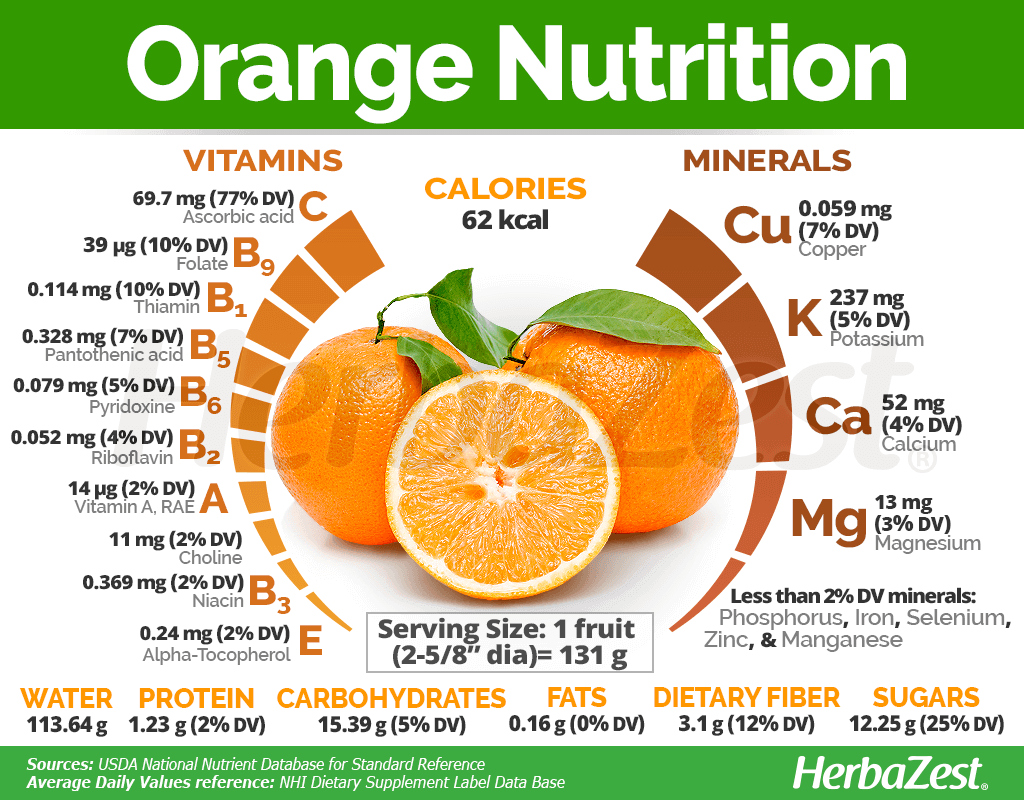
How to Consume Orange
- Edible parts Fruit, Oil
- Edible uses Beverage, Oil
- Taste Aromatic, Sweet, Pungent
Oranges have a myriad of culinary uses. Their juice can be added to sauces as well as used as an ingredient for many savory and sweet dishes. While orange benefits are better reaped from its natural state, a number of remedial forms exist and can be used to take advantage of the medicinal properties of this citrus fruit.
Natural Forms
Raw. Fresh oranges can be eaten in their natural state.
Cooked. Both the peel and the juicy flesh of oranges are used to prepare jams, cookies, cakes, candies, and baked goods.
Juice. Oranges are a widely preferred choice for breakfast juice, in both fresh or processed forms. For a healthy dose of fiber, it is better to drink orange juice including the pulp of the fruit.
Dried. Orange flesh and peel can be dried and used as a healthy snack or an ingredient for desserts.
Seed Oil. Not as popular as other types of oils, orange seed oil can also be used in cooking.
Herbal Remedies & Supplements
Vitamin supplements do not provide as much protective benefits as drinking a glass of orange juice.
Essential oil. Sweet orange essential oil can be used topically for skin rejuvenation as well as for relieving eczema, dermatitis, and other skin conditions. It is also popularly used in aromatherapy for reducing fatigue, palpitations, premenstrual tension, menopause symptoms, and stress. Bitter orange essential oil is commonly used for treating acne and wounds. Both oils can soothe anxiety and help treating insomnia.
Liquid extract. This non-alcoholic, concentrated solution is obtained from the peel of sweet oranges. It has been traditionally used for relieving indigestion and nausea, but it also possesses antimicrobial properties that are currently used to treat fungal infections and other skin problems.
Distilled water. The orange flowers are processed to obtain a liquid with a subtle floral flavor, better known as 'orange blossom water.' This preparation has been traditionally used to flavor some Arabic desserts as well as for calming the nerves and treating insomnia.
Capsules. Sweet oranges are rich in vitamin C (ascorbic acid), which is isolated and consumed as a daily supplement in standardized doses for to its anti-inflammatory, antioxidant, and immune boosting properties.
The ascorbic acid extracted from oranges is added to soda and cocktail drinks, punches, and even liqueurs.
Growing
- Life cycle Perennial
- Harvested parts Flowers, Leaves, Fruit
- Light requirements Full sun
- Soil Loamy sand
- Soil pH 5.6 – 6.0 (Moderately acidic), 6.1 – 6.5 (Slightly acidic), 6.6 – 7.3 (Neutral)
- Growing habitat Subtropical regions
- USDA Plant Hardiness Zones 12b
- Planting time Early spring
- Plant spacing average 7 m (22.97 ft)
- Potential insect pests Aphids, Moths
- Potential diseases Pox virus
Orange trees can grow to a height of 16 - 49 feet (6 - 15 m) and live for periods of more than 100 years. Orange is a subtropical species, so this trees grows best in warm regions with a pronounced change in season.
Growing Guidelines
The ideal range of temperature for oranges is between 55 - 100°F (13 - 38°C) during the growing season and 35 - 50°F (2 - 10°C) during dormancy. While mature orange trees may be able to survive short periods of freezing, young trees will be killed, so they need to be protected from extreme weather.
The orange plant prefers well-drained, sandy loam soils, with a pH between 6.0 and 7.5.
The young orange trees require soils deep enough to allow for adequate root development.
Being subtropical trees, oranges require full sun as well as protection from the wind in order to prevent damage.
Preferred annual precipitation ranges from 5 - 20 inches (130 - 500 mm), though oranges are frequently grown in areas receiving 40 - 60 inches (1,000 - 1,500 mm).
Although oranges can be grown from seeds, the most common form of reproduction is by budding onto appropriate root-stocks. Orange blossoms yield very little pollen, but orange growers do not practice artificial pollination except in the case of hybrids, where honeybees are mostly used for cross-pollination.
Common distances between orange trees go from 20 - 25 feet (6 - 7.5 m) to 10 - 15 feet (3 - 4.5 m), depending on the area covered by the crop. Close-spacing requires expensive pruning and negatively affects the production.
Additional Information
- Other uses Cosmetics, Cleaning, Disinfectant, Perfume
Plant Biology
The sweet orange tree is an evergreen, branched with a rounded crown and oval leaves that are alternately arranged on the branches and have slightly feathered petioles. Its white flowers can bloom individually or gathered in a group. The orange fruit is a spherical berry with a green-yellow to orange skin and segmented, pulpy flesh with several seeds.
Classification
Botanically known as Citrus sinensis, orange belongs to the Rutaceae family, which comprises over 900 species across 150 genera, including economically important citrus fruits such as lemon (Citrus limon), lime (Citrus aurantiifolia), and grapefruit (Citrus paradisi), along with medicinal herbs like rue (Ruta graveolens).
Varieties and Cultivars of Orange
Most of the oranges grown in the U.S. come from California and Florida. The first uses two cultivars, 'Washington Navel' and 'Valencia,' while Florida's commercial cultivars are mainly 'Hamlin,' 'Pineapple,' and 'Valencia.'
In Brazil, the biggest producer of oranges, major cultivars include the late ripening 'Pera,' 'Natal,' and 'Valencia.' Together, they account for about 70% of orange production. They supply fruits from June to December and in smaller amounts up to March of the following year. The ripening season for early varieties, like 'Bahia' and 'Baianinha' navels, goes from March through June.
Historical Information
The orange tree is thought to be native to southern China, northeastern India, and perhaps southeastern Asia. Historical data indicates that oranges were probably introduced to the Mediterranean area by Italian or Portuguese traders around 1450-1500.
Citrus fruits were highly regarded by Europeans, mainly for medicinal purposes, but the orange was quickly adopted as a succulent fruit by wealthy people, and it was grown in private conservatories called orangeries.
The Spaniards brought the orange fruit to South America and Mexico in the mid-1500s, and it is thought that the French introduced it to North America.
Economic Data
Citrus sinensis is one of the most important and widely grown fruit crop, with total global production reported to be around 120 million tons. The orange fruit is cultivated in more than 130 countries, including Brazil, the U.S., India, the U.K., France, Germany, Holland, China, and Spain. In worldwide trade, citrus fruits generate about $105 billion USD annually all over the world.
Brazil is the leading producer of oranges, followed by the United States.
Popular Beliefs
During the Victorian times, it was popular for brides to carry fresh orange blossoms, even as wreaths attached to their veils, as a symbol of love and future prosperity. In the Chinese culture, the orange is a symbol of good luck.
Other uses
Aromatherapy. Orange essential oil is used in aromatherapy for relaxation.
Cosmetic industry. The essential oil extracted from oranges' peels, flowers, leaves, and twigs has aromatic properties that are used in cosmetics, perfumes, creams, and soaps.
Pharmaceutical industry. The volatile oils extracted from sweet oranges are used in pharmaceutical products for their antibacterial properties.
Beverage industry. The ascorbic acid of oranges is added to many commercial beverages with the purpose of enriching their nutritional value.
Honey production. Orange blossoms produce more nectar than any other source in the U.S. and are important for honey production - more than 25% of honey produced in California is from orange groves.
Industrial uses. The orange peel is also used as a component in plastics and cleaning products, and it is powdered for dietary and sports supplements.
Sources
- 100 Families of Flowering Plants, p. 295
- American Journal of Respiratory and Critical Care Medicine, Effects of Changes in Fresh Fruit Consumption on Ventilatory Function in Healthy British Adults, 1998
- Aromatherapy Science: A Guide for Healthcare Professionals, p. 261
- British Journal of General Practice, Aromatherapy: a systematic review, 2000
- Floriography Today
- Food Chemistry, Citrus paradisi and Citrus sinensis flavonoids: Their influence in the defence mechanism against Penicillium digitatum, 2006 | Citrus flavonoids: Molecular structure, biological activity and nutritional properties: A review, 2007
- Fruits of Warm Climates, Orange. pp. 134–142
- Harvard Health Publications, Glycemic index for 60+ foods
- Journal of the American Dietetic Association, Overview of the health benefits of fruit and vegetable consumption for the dietetics professional: selected literature, 2000
- Molecules, Carotenoids and Their Isomers: Color Pigments in Fruits and Vegetables, 2011
- National Library of Medicine, PubMed Health, No proof orange juice boosts brain power, 2015
- Nutrients, B Vitamins and the Brain: Mechanisms, Dose and Efficacy—A Review, 2016
- Penn State University, PlantVillage, Orange
- Texas A&M Agrilife Extension, Pectin: Health ingredient of the future?
- The Encyclopedia of Herbs and Spices, p. 692
- University of Florida, Florida Citrus Resources, The Brazilian Citrus Industry
- World Agroforestry Centre, Citrus Sinensis
- FAOSTAT, Corporate Document Repository, Nutritional and Health Benefits of Citrus Fruits
- Journal of Medicinal Food, Medicinal values of fruit peels from Citrus sinensis, Punica granatum, and Musa paradisiaca with respect to alterations in tissue lipid peroxidation and serum concentration of glucose, insulin, and thyroid hormones, 2008
- Phytotherapy Research, Hesperidin suppressed proliferations of both human breast cancer and androgen-dependent prostate cancer cells, 2010
- Integrated Taxonomic Information System, Rutaceae of North America Update
Footnotes:
- Preventive Nutrition and Food Science. (2014). Antioxidant Activity of Orange Flesh and Peel Extracted with Various Solvents. Retrieved Nvmber 17, 2021, from: https://www.ncbi.nlm.nih.gov/pmc/articles/PMC4287321/
- International Journal of Molecular Sciences. (2019). Carotenoids as Novel Therapeutic Molecules Against Neurodegenerative Disorders: Chemistry and Molecular Docking Analysis. Retrieved Nvmber 17, 2021, from: https://www.ncbi.nlm.nih.gov/pmc/articles/PMC6888440/
- Journal of Pharmacy & BioAllied Sciences. (2016). Antihyperlipidemic effects of Citrus sinensis, Citrus paradisi, and their combinations. Retrieved Nvmber 17, 2021, from: https://www.ncbi.nlm.nih.gov/pmc/articles/PMC4832900/
